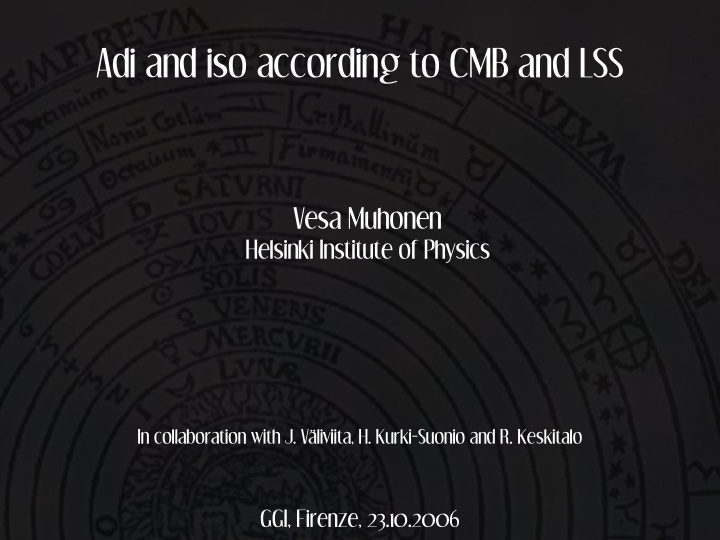



Adi and iso according to CMB and LSS Vesa Muhonen Helsinki Institute of Physics In collaboration with J. Väliviita, H. Kurki-Suonio and R. Keskitalo GGI, Firenze, 23.10.2006
What? We are considering events well after any process that generated the primordial perturbations. ● e.g., well after the end of inflation In general there are the curvature perturbations R and the entropy perturbations S (can be several kinds of). A general perturbation can be then divided into an adiabatic and an isocurvature mode ● adi: initially R ≠ 0 and S = 0 ● iso: initially R = 0 and S ≠ 0 Adi and iso can be correlated since entropy perturbations can source curvature perturbations even on superhorizon scales.
Why? We know that a simple adiabatic model is a very good fit to the data. ● Is isocurvature better constrained by the WMAP 3-year data? – revisit our earlier results ● How much isocurvature does the data allow? – it's not difficult to produce isocurvature ● e.g., multi-field inflation
How? ● We consider a spatially flat universe – dark energy is the cosmological constant – CDM isocurvature ● We use the CMB data from WMAP-3 with additional small scale data and LSS data from SDSS ● The total C l is a sum of four components ● In total there are 11 parameters ● Then we do a normal MCMC analysis
What do we find? The isocurvature model is a slightly better fit to the data ● in terms of χ² the improvement is Δχ² ~ 10 Slightly better fit Better constrained due to to BBN values. WMAP polarization data.
Surprisingly, the WMAP 3-year data does not lead to tighter constraints on the isocurvature parameters. A non-adiabatic contribution ~5% is allowed by the data.
Better data here will improve the constraints
There are some effects, however, on the other parameters...
Conclusions ● The CMB is dominantly adiabatic, but a small isocurvature component is clearly allowed – this is true even with the latest more accurate data – there might be a small feature that can be explained with iso – more accurate data on the 2 nd and 3 rd peak will give further constraints ● In the observed CMB spectra there can be ~5% non- adiabatic contribution
To calculate the CMB power spectra, one needs the curvature and entropy perturbations given deep in the radiation dominated era. A correlation between two random variables is given by:
Approximating the power spectra and the transfer functions by power laws leads to: The total CMB angular power spectrum is now:
Recommend
More recommend